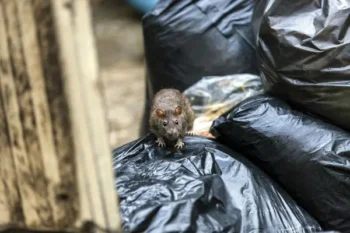
Rats generally thrive outdoors, searching for shelter, sustenance, and protection from predators. These adaptable creatures can thrive in various environments, both inside buildings and outdoors. Understanding their preferred habitats is crucial for detecting and effectively managing potential infestations.
Different types of rats and mice exhibit unique behaviors that determine where they might choose to settle in your home or garden. Their nesting site preferences vary depending on the species:
- House Mice and Deer Mice: House mice and deer mice are smaller rodents that prefer cozy, hidden spots. They are frequently found nesting in tree hollows, under rocks, or other protected areas. Their small size allows them to exploit various nooks and crannies that larger rodents cannot access.
- Norway Rats: Norway rats are known for their burrowing habits. These rats often create nests in areas with dense vegetation or underground, such as beneath the foundations of buildings. They prefer locations that provide them with concealment and protection from the elements and predators.
- Roof Rats: Roof rats are adept climbers and typically make their homes in high places like trees or on the roofs of houses. They prefer elevated locations that offer safety from ground-level predators and easy access to food sources, such as fruit trees and garden produce.
Do You Have a Rodent Problem? We Can Help.
Click the button below to leave your information & we'll be in touch in an hour or less.
Rat Nesting Sites: Indoors vs. Outdoors
When it comes to indoor environments, rats and mice seek out places that offer warmth, quiet, and close access to food. Common indoor nesting sites include:
- Attics: Rodents find isolated corners or burrow into insulation materials to set up their nests in attics. The quiet and infrequent human activity make attics an ideal nesting site.
- Wall Voids: The hidden spaces inside walls provide a secure environment for rodents to nest and multiply. Wall voids offer a safe haven where rodents can remain undetected while they breed and forage for food.
- Basements and Crawl Spaces: Basements and crawl spaces are typically dark and quiet, with plenty of clutter, making them ideal for rodents. These areas often provide easy access to food sources and nesting materials.
- Storage Areas: Rodents often utilize cluttered spaces and the materials stored there, like boxes and insulation, to build their nests. Storage areas offer plenty of hiding spots and nesting materials, making them attractive to rodents.
Rats can also establish a range of outdoor habitats, each chosen for its ability to provide safety, sustenance, and protection. Here are some of the most common outdoor locations where rats are likely to nest:
- Underground Burrows: Some rats prefer to dig and create extensive burrow systems. These are often located under piles of debris, dense vegetation, or even beneath buildings, where they can stay hidden and protected from the elements and predators.
- Dense Vegetation: Tall grasses and shrubs offer excellent cover for rats. They use these areas to hide, forage for food, and build nests away from the prying eyes of predators and humans.
- Wood Piles and Junkyards: These locations provide rats with a secluded and sheltered environment. The clutter and debris give them ample materials to construct their nests and stay out of sight.
- Gardens and Fields: Rats are drawn to gardens and fields that offer ample food supplies and shelter in the form of mulch, vegetation, and garden debris. These environments support their need for concealment and constant access to food sources.
- Streams and Riverbanks: These areas provide a steady water source, which is essential for rat colonies. Rats often build their nests close to these water bodies in burrows that protect them from the elements and offer quick escape routes.
Where Do Mice Live?
Mice are highly adaptable, making them capable of surviving in various environments. They often seek places that provide ample food, water, and shelter. Here are some common areas where mice tend to reside:
Mice thrive in outdoor areas with plenty of grass and plant cover to hide from predators. They often build burrows to stay safe and warm. Barns and granaries are also ideal for mice because they usually offer easy access to food and have many hidden nooks where they can nest undisturbed.
Mice also seek the warmth and security of houses inside, especially during colder months. They are particularly fond of quiet, less-frequented areas like attics, basements, and wall voids. Inside, they can be close to food sources like kitchens and pantries while remaining hidden from sight.
If you suspect a mouse infestation, have the experts at Russell’s Pest Control inspect these areas closely and offer tailored rodent control solutions.
We Identify and Address Rodent Infestations
Locating nests of rodents within a home can be a real challenge since they tend to steer clear of human activity. Signs of an infestation, such as finding droppings or noticing gnaw marks, typically appear before the actual rodents are seen.
In these situations, it is crucial to act quickly and seek professional rodent extermination from Russell’s Pest Control to remove the pests efficiently and prevent them from returning. Our experts use advanced techniques and eco-friendly methods to make sure your home is free from rodents. Contact us today to get started with a free service quote!
Back to Rodent IdentificationWhere Do Rats Live? in Knoxville TN
Serving East Tennessee since 1971